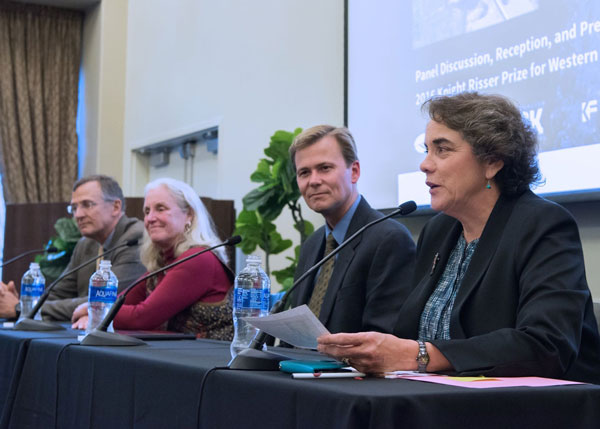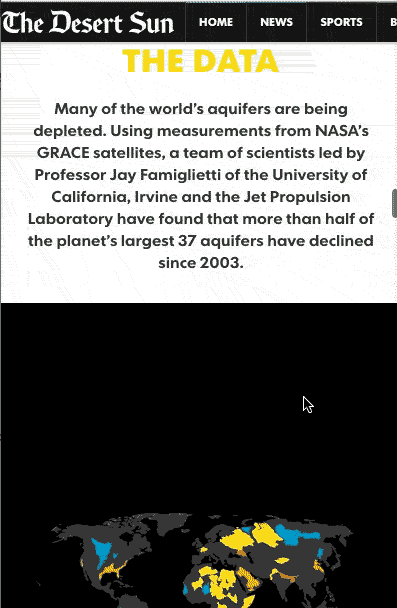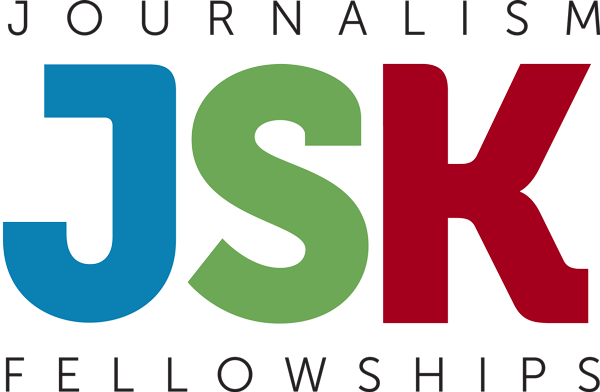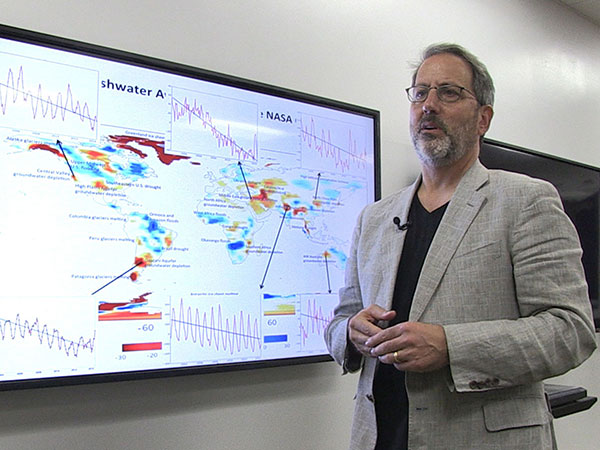
The Bill Lane Center for the American West, Stanford University
Desert Sun/USA Today Exploration of Groundwater Overuse Wins 2016 Knight-Risser Prize
“Pumped Dry: The Global Crisis of Vanishing Groundwater”, a joint project of The Desert Sun and USA Today, has won the 2016 Knight-Risser Prize for Western Environmental Journalism. The prize goes to Desert Sun reporter Ian James, USA Today’s Steve Elfers, a videojournalist, and Steve Reilly, a reporter and data specialist.
Special Recognition Citation
Special Recognition was given to “Killing the Colorado,” a five-part series by ProPublica reporter Abrahm Lustgarten, exposing the western water crisis as the result of generations of legislative and legal decisions influenced by greed, political cowardice and willful ignorance of basic science. The series was produced in partnership with the online science and environment publication Matter.
The Knight-Risser Prize, which bestows a cash award of $5,000, recognizes the best environmental reporting on the North American West — from Canada through the United States to Mexico. Winners participate in the Knight-Risser Prize Symposium, an annual environmental forum at Stanford.
More information about the symposium will be coming soon. To find out when the symposium has been announced, please follow us on Twitter at @KnightRisser.
 Read a summary of the 2017 Knight Risser Prize Symposium with photos and complete audio and video here.
Read a summary of the 2017 Knight Risser Prize Symposium with photos and complete audio and video here.
Grape harvesting in Paso Robles, California, one of many regions that depend heavily on groundwater pumping for agriculture.
Starting from California, Winning Series Spans the Globe
Supported by a team of journalists and a travel grant from the Pulitzer Center on Crisis Reporting, James and Elfers traveled to farms in California, Kansas, India, Peru, and Morocco. In stories, photographs and information graphics, they identified a water crisis that exists not just in the West but across the country and the globe. Through interviews with scientists, farmers, government officials and residents, they illustrated how the unchecked use of underground water threatens not just current but future water supplies. The series also spawned a documentary that was shown at film festivals in Sonoma and Palm Springs, Calif., as well as Toronto and Washington D.C.
James and his Desert Sun colleague Jay Calderon had previously won a Special Recognition in the 2014 Knight-Risser Prize for a series on groundwater depletion in California. James proposed taking a wider look when NASA satellite measurements showed aquifers threatened worldwide.
Watch the Video of Ian James’ Remarks to the Knight-Risser Prize Symposium (Story continues below)
“Ian James and his colleagues have been relentless in covering water issues,” said Paul Rogers, resources and environment writer for the San Jose Mercury News and managing editor of the KQED Science Unit. “The Desert Sun is doing an amazing job. It’s a relatively small paper in Palm Springs, which is a community with little rainfall and lots of golf courses where reforms aren’t always embraced. Their work is informing their community and readers around California and the nation.”
Rogers was one of five journalists and environmental experts who judged the contest. The others were Meg Caldwell, deputy director, oceans, David and Lucille Packard Foundation; Jay Hamilton, Stanford professor of communication and director of the Stanford Journalism Program; Jim Morris, managing editor for environment and labor at the Center for Public Integrity, and co-winner of the 2015 Knight-Risser Prize; and Patty Talahongva, a print and television journalist, independent documentary filmmaker and former president of the Native American Journalists Association.
Hamilton commended the series’ color-coded graphics showing aquifer hotspots. Rogers found the writing clear and to the point for what can be a dense topic, and the series timely.“I was astounded at how far this reporter went – Peru, Morocco,” he said. “Those places are the Ghost of Christmas Future if we don’t get our act together.”

The severity of groundwater overdraft in global hotspots is shown here in an animated visualization of data from NASA and the Jet Propulsion Laboratory.
The Desert Sun
“Pumped Dry” details the impacts of falling water tables in California, beneath cornfields in Kansas, rice paddies in India, asparagus farms in Peru and orange groves in Morocco. Pumped beyond their limits, many aquifers have declined dramatically and growing numbers of wells have gone dry. As these water reserves dwindle, the threats are mounting for people who depend on groundwater to supply agriculture, sustain economies and provide drinking water. Conflicts over water are on the rise and farmers are being forced to switch crops or go into debt. In some areas, fields have turned to dust and farmers are facing unprecedented hardships.
“I proposed this series to investigate the consequences of this pervasive problem and report on how it’s affecting people in places around the world,” James said. “The project involved collaborative work by a team of journalists at USA Today and The Desert Sun, who built on our data analysis and stories with graphics and maps illustrating areas where aquifers are rapidly declining. We’re deeply honored to have this work recognized with the Knight-Risser Prize, and we hope the series and the documentary will continue to generate more discussion about this critically important problem and steps that can be taken to address it.”
In the United States, nearly two-thirds of the groundwater pumped from wells is used for agriculture, the rest for cities and expanding development and industries.
In analyzing two decades of U.S. Geological Survey data, USA Today and The Desert Sun found water levels dropping in nearly two-thirds, or 64 percent, of more than 32,000 wells across the country. The average decline was more than 10 feet and in some areas more than 100 feet. As the drought in the West intensified from 2011 to 2014, so did groundwater pumping.
Despite satellite evidence of this looming global crisis, the series showed, little is being done to regulate pumping or conserve groundwater.
Climate change will only exacerbate the problem. Across the globe, people are pumping ever deeper to find water. They’re now tapping underground reservoirs built up over tens of thousands of years. It could take that long for nature to replenish them.
About the Prize and the Judging
The Knight-Risser Prize will be awarded at a symposium to be held at Stanford in early 2017. The event will bring together journalists, researchers, policymakers, advocates, students, and the public to explore the environmental issues raised by the winning entry. The prize is co-sponsored by the John S. Knight Journalism Fellowships and the Bill Lane Center for the American West at Stanford, with support from the John S. and James L. Knight Foundation.
The Knight-Risser Prize for Western Environmental Journalism is a joint venture of the John S. and James L. Knight Foundation, the John S. Knight Journalism Fellowships at Stanford and the Bill Lane Center for the American West at Stanford.
Prize Administrators and Sponsors
 The John S. and James L. Knight Foundation supports transformational ideas that promote quality journalism, advance media innovation, engage communities and foster the arts. The foundation believes that democracy thrives when people and communities are informed and engaged.
The John S. and James L. Knight Foundation supports transformational ideas that promote quality journalism, advance media innovation, engage communities and foster the arts. The foundation believes that democracy thrives when people and communities are informed and engaged.
 The John S. Knight Journalism Fellowships at Stanford is an ambitious catalyst for journalism innovation, entrepreneurship and leadership. Fellows spend their year absorbing knowledge, honing skills and developing journalism prototypes. They leverage the resources of a great university and Silicon Valley while learning from rich interactions with journalists from around the world.
The John S. Knight Journalism Fellowships at Stanford is an ambitious catalyst for journalism innovation, entrepreneurship and leadership. Fellows spend their year absorbing knowledge, honing skills and developing journalism prototypes. They leverage the resources of a great university and Silicon Valley while learning from rich interactions with journalists from around the world.
 The Bill Lane Center for the American West is a Stanford University research institute dedicated to advancing scholarly and public understanding of the past, present, and future of western North America. The Center supports research, teaching, and reporting about western land and life in the United States, Canada, and Mexico.
The Bill Lane Center for the American West is a Stanford University research institute dedicated to advancing scholarly and public understanding of the past, present, and future of western North America. The Center supports research, teaching, and reporting about western land and life in the United States, Canada, and Mexico.

– Paul Rogers, 2015 Knight-Risser Prize judge

– Ian James, author of “Pumped Dry”
Texas Tribune, ProPublica

The Desert Sun and USA Today

CPI, InsideClimate News, The Weather Channel

The Seattle Times

The Sacramento Bee

High Country News

5280 Magazine

Seattle Post-Intelligencer

What Went Wrong?
The Seattle Times

San Antonio Express-News

The Los Angeles Times

High Country News




